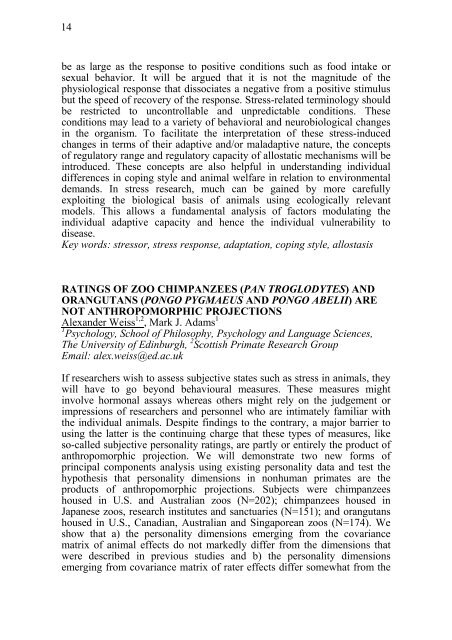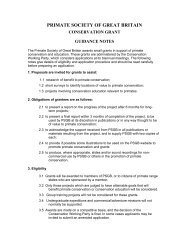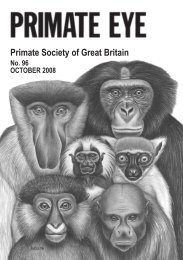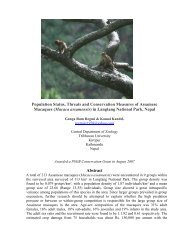2009 Vol 99.pdf (2.45mb) - Primate Society of Great Britain
2009 Vol 99.pdf (2.45mb) - Primate Society of Great Britain
2009 Vol 99.pdf (2.45mb) - Primate Society of Great Britain
Create successful ePaper yourself
Turn your PDF publications into a flip-book with our unique Google optimized e-Paper software.
14<br />
be as large as the response to positive conditions such as food intake or<br />
sexual behavior. It will be argued that it is not the magnitude <strong>of</strong> the<br />
physiological response that dissociates a negative from a positive stimulus<br />
but the speed <strong>of</strong> recovery <strong>of</strong> the response. Stress-related terminology should<br />
be restricted to uncontrollable and unpredictable conditions. These<br />
conditions may lead to a variety <strong>of</strong> behavioral and neurobiological changes<br />
in the organism. To facilitate the interpretation <strong>of</strong> these stress-induced<br />
changes in terms <strong>of</strong> their adaptive and/or maladaptive nature, the concepts<br />
<strong>of</strong> regulatory range and regulatory capacity <strong>of</strong> allostatic mechanisms will be<br />
introduced. These concepts are also helpful in understanding individual<br />
differences in coping style and animal welfare in relation to environmental<br />
demands. In stress research, much can be gained by more carefully<br />
exploiting the biological basis <strong>of</strong> animals using ecologically relevant<br />
models. This allows a fundamental analysis <strong>of</strong> factors modulating the<br />
individual adaptive capacity and hence the individual vulnerability to<br />
disease.<br />
Key words: stressor, stress response, adaptation, coping style, allostasis<br />
RATINGS OF ZOO CHIMPANZEES (PAN TROGLODYTES) AND<br />
ORANGUTANS (PONGO PYGMAEUS AND PONGO ABELII) ARE<br />
NOT ANTHROPOMORPHIC PROJECTIONS<br />
Alexander Weiss 1,2 , Mark J. Adams 1<br />
1 Psychology, School <strong>of</strong> Philosophy, Psychology and Language Sciences,<br />
The University <strong>of</strong> Edinburgh, 2 Scottish <strong>Primate</strong> Research Group<br />
Email: alex.weiss@ed.ac.uk<br />
If researchers wish to assess subjective states such as stress in animals, they<br />
will have to go beyond behavioural measures. These measures might<br />
involve hormonal assays whereas others might rely on the judgement or<br />
impressions <strong>of</strong> researchers and personnel who are intimately familiar with<br />
the individual animals. Despite findings to the contrary, a major barrier to<br />
using the latter is the continuing charge that these types <strong>of</strong> measures, like<br />
so-called subjective personality ratings, are partly or entirely the product <strong>of</strong><br />
anthropomorphic projection. We will demonstrate two new forms <strong>of</strong><br />
principal components analysis using existing personality data and test the<br />
hypothesis that personality dimensions in nonhuman primates are the<br />
products <strong>of</strong> anthropomorphic projections. Subjects were chimpanzees<br />
housed in U.S. and Australian zoos (N=202); chimpanzees housed in<br />
Japanese zoos, research institutes and sanctuaries (N=151); and orangutans<br />
housed in U.S., Canadian, Australian and Singaporean zoos (N=174). We<br />
show that a) the personality dimensions emerging from the covariance<br />
matrix <strong>of</strong> animal effects do not markedly differ from the dimensions that<br />
were described in previous studies and b) the personality dimensions<br />
emerging from covariance matrix <strong>of</strong> rater effects differ somewhat from the






